Aspect Ratio
When High Fidelity is enabled, the Aspect Ratio metric is calculated using the ratio of the lengths of sides. The details vary depending on the type of surface element (face).
Aspect Ratio Calculation for Triangles
The aspect ratio for a triangle is computed in the following manner, using only the corner nodes of the element.
For each node (I, J, and K in the following image), a line is constructed from that node of the element to the midpoint of the opposite edge, and another through the midpoints of the other 2 edges. In general, these lines are not perpendicular to each other or to any of the element edges.
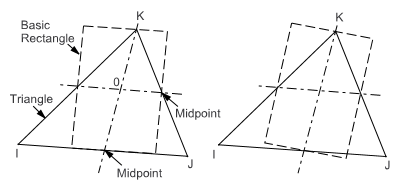
Rectangles are constructed centered about each of the 2 lines, with two edges parallel to one of the lines, and all edges passing through the element edge midpoints and the triangle apex.
These constructions are repeated using each of the other 2 corners as the apex.
The Aspect Ratio of the triangle is the ratio of the longer side to the shorter side of whichever of the 6 rectangles is most stretched, divided by the square root of 3.
The best possible triangle aspect ratio occurs for an equilateral triangle and is 1. A comparison between an equilateral triangle and a triangle having an aspect ratio of 20 is shown below.

Aspect Ratio Calculation for Quadrilaterals
The aspect ratio for a quadrilateral is computed by the following steps, using only the corner nodes of the element.
- If the element is not flat, the nodes (I, J, K, and L in the following image) are projected onto a plane passing through the average of the corner locations and perpendicular to the average of the corner normals. The remaining steps are performed on these projected locations.
- Two lines are constructed that bisect the opposing pairs of element edges
and which meet at the element center. In general, these lines are not
perpendicular to each other or to any of the element edges.
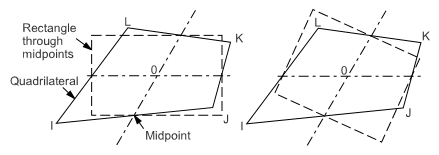
- Rectangles are constructed centered about each of the 2 lines, with two edges parallel to one of the lines, and with all edges passing through the element edge midpoints.
- The Aspect Ratio of the quadrilateral is the ratio of a longer side to a shorter side of whichever rectangle is most stretched.
The best possible quadrilateral aspect ratio occurs for a flat square and is one. A comparison between a square and a quadrilateral having an aspect ratio of 20 is shown below.
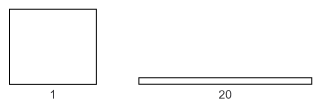
Aspect Ratio for Hexahedra
The Aspect Ratio metric for hexahedral elements is defined as the size of the minimum element edge divided by the size of the maximum element edge. The values are scaled and the default range of values is 1-20, such that an Aspect ratio of 1 indicates a regular element.
When High Fidelity is disabled, the Aspect Ratio metric is calculated for different element types as follows:
Aspect Ratio for Quadrilaterals/Pyramids
The aspect ratio is the Determinant, which is the ratio of the smallest determinant of the Jacobian matrix divided by the largest determinant of the Jacobian matrix, where each determinant is computed at each node of the element. A value of 1 would indicate a perfectly regular mesh element, 0 would indicate an element degenerate in one or more edges, and negative values would indicate inverted elements.
Aspect Ratio for Prisms
The quality is calculated as the minimum of the Determinant and Warpage. The Determinant is the ratio of the smallest determinant of the Jacobian matrix divided by the largest determinant of the Jacobian matrix, where each determinant is computed at each node of the element. Warpage is normalized to a factor between 0 to 1, where 90 degrees is 0, and 0 degrees is 1.
Aspect Ratio for Hexahedra
The quality is a weighted diagnostic between Determinant (between -1 and 1), Max Orthogls (normalized between -1 and 1; if deviation from orthogonality is greater than 90 degrees, then the normalized value will be smaller than 0) and Max Warpgls (normalized between 0 and 1; warpage of 0 degrees is 1, warpage of 180 degrees is 0). The minimum of the 3 normalized diagnostics will be used.
The Determinant is the ratio of the smallest determinant of the Jacobian matrix divided by the largest determinant of the Jacobian matrix, where each determinant is computed at each node of the element.
The Max Orthogls calculates the maximum deviation of the internal angles of the elements from 90 degrees. For hexahedra, angles between 180 and 360 degrees are also considered (deviation up to 270 degrees).
To determine the warp of a quadrilateral face, the angles between the triangles connected at the 2 diagonals of the quad will be calculated and the maximum will be used. The maximum warp of the hexahedral element is the maximum warp of its quad faces.
Aspect Ratio for Triangles
The ratio between the area of triangle and the maximum edge length for each element is calculated. The values are scaled, so that an aspect ratio of 1 corresponds to a perfectly regular element, while an aspect ratio of 0 indicates that the element has zero area.
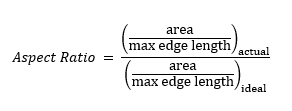
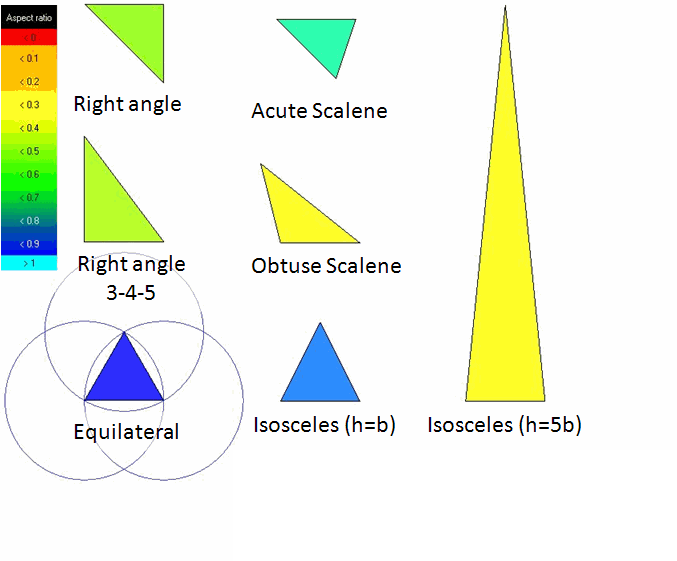
Aspect Ratio for Tetrahedra
The ratio between the volume of the element and the radius of its circumscribed sphere power three is calculated. The values are scaled, so that an aspect ratio of 1 corresponds to a perfectly regular element, while an aspect ratio of 0 indicates that the element has zero volume.




